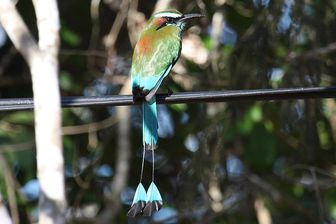Turquoise-browed Motmot
The bird is approximately 34 cm long and weighs about 65 grams. It has a mostly green body with a rufous back and belly. There is a bright blue stripe above the eye and a blue-bordered black patch on the throat. The flight feathers and upperside of the tail are blue. The tips of the tail feathers are shaped like rackets and the bare feather shafts are longer than in other motmots. Although it is often said that motmots pluck the barbs off their tail to create the racketed shape, this is not true; the barbs are weakly attached and fall off due to abrasion with substrates and with routine preening.

Original source: originally posted to Flickr as Turquoise-browed Motmot
Author: Alastair RaePermission(Reusing this file)This image, which was originally posted to Flickr.com, was uploaded to Commons using Flickr upload bot on 17:40, 31 March 2010 (UTC) by Snowmanradio (talk). On that date it was licensed under the license below. This file is licensed under the Creative Commons Attribution-Share Alike 2.0 Generic license.You are free:to share – to copy, distribute and transmit the work
The Turquoise-browed Motmot is classified as Least Concern. Does not qualify for a more at risk category. Widespread and abundant taxa are included in this category.
Turquoise-browed Motmot in Costa Rican Pacific Dry Forests (photographed by Leonardo C. Fleck) The bird is approximately 34 cm long and weighs about 65 grams. It has a mostly green body with a rufous back and belly. There is a bright blue stripe above the eye and a blue-bordered black patch on the throat. The flight feathers and upperside of the tail are blue. More
predators (based on studies on Turquoise-browed Motmot) and that the display is likely to communicate that the motmot is aware of the predator and is prepared to escape. This form of interspecific pursuit-deterrent signal provides a benefit to both the motmot and the predator: the display prevents the motmot from wasting time and energy fleeing, and the predator avoids a costly pursuit that is unlikely to result in capture. More
The Turquoise-browed Motmot (Eumomota superciliosa) is a colourful, medium-sized bird of the motmot family, Momotidae. It inhabits Central America from south-east Mexico (mostly the Yucat More
the Turquoise-browed Motmot expresses the extraordinary racketed tail in both sexes. Research indicates that the tail has evolved to function differently for the sexes. Males apparently use their tail as a sexual signal, as males with longer tails have greater pairing success and reproductive success. In addition to this function, the tail is used by both sexes in a wag-display, whereby the tail is moved back-and-forth in a pendulous fashion. More
Eumomota superciliosa, the turquoise-browed motmot, breeds in holes which males and females typically dig into the soil. In Mexico, however, turquoise-browed motmots make use of uninhabited Mayan ruins, laying eggs and raising chicks in the shelter of elaborate stone buildings and pyramids that were abandoned by native peoples over a thousand years ago. Turquoise-browed motmots are also called "tik-tok birds", because they use their tails to communicate. More
The Turquoise-browed Motmot is a well-known bird in its range and has been chosen as the national bird of both El Salvador and Nicaragua. It has acquired a number of local names including guardabarranco ("ravine-guard") in Nicaragua, torogoz in El Salvador (based on its call) and pájaro reloj ("clock bird") in the Yucatán, based on its habit of wagging its tail like a pendulum. In Costa Rica it is known as Momoto Cejiceleste. http://en.wikipedia. More
Even in silhouette the Turquoise-browed Motmot is easy to identify, for the tail's long "naked shafts" are distinctive for the species; other motmots in our area show much less open space in the tail. The other day a tourist visiting the hacienda asked me if the northern Yucatan had any birds as spectacular as the toucans and macaws he'd seen in Guatemala. I replied that our motmots surely were as colorful and exotic, if not quite as large. More
The Turquoise-browed Motmot (Eumomota superciliosa) is a species of bird of the Motmot family, Motmotidae. It is found in Central America from south to east Mexico (Yucatan Peninsula), and in Costa Rica. Its lives in open areas of scrubland and forest edges. It is more noticeable than other motmots, and will often perch in the open on wires and fences. This bird is about 13.33 inches long and weighs close to 2.25 ounces. Its body is mostly green with a brownish-red back and belly. More
turquoise-browed motmots are often absent from breeding grounds for most of February, but return in March. Such seasonal movements are likely associated with changes in habitat association, but the family is mostly nonmigratory. Feeding ecology and diet Motmots are omnivorous, taking invertebrates, small animals, and fruits. Invertebrates include beetles, butterflies (Morphos) and caterpillars, dragonflies, mantises, cicadas, spiders, centipedes, millipedes, scorpions, snails, earthworms, and crabs. More
For the purposes of our bird news services, Turquoise-browed Motmot is classed as Ungraded: species that are unlikely to appear as wild birds in Britain or Ireland hide section Most recent photos of Turquoise-browed Motmot (1) Ensenada Lodge, Puntarenas, Costa Rica Ensenada Lodge, Puntarenas, Costa Rica07/12/2009 Ensenada Lodge, Puntarenas, Costa Rica 07/12/2009 View all pictures of Turquoise-browed Motmot View all pictures of Turquoise-browed Motmot show section External Links (0) We currently have no More

Original source: Bernd Kirschner
Author: Bernd Kirschner
Permission: Some rights reserved
Family : Momotidae
Genus : Eumomota
Species : superciliosa
Authority : (Sandbach, 1837)
